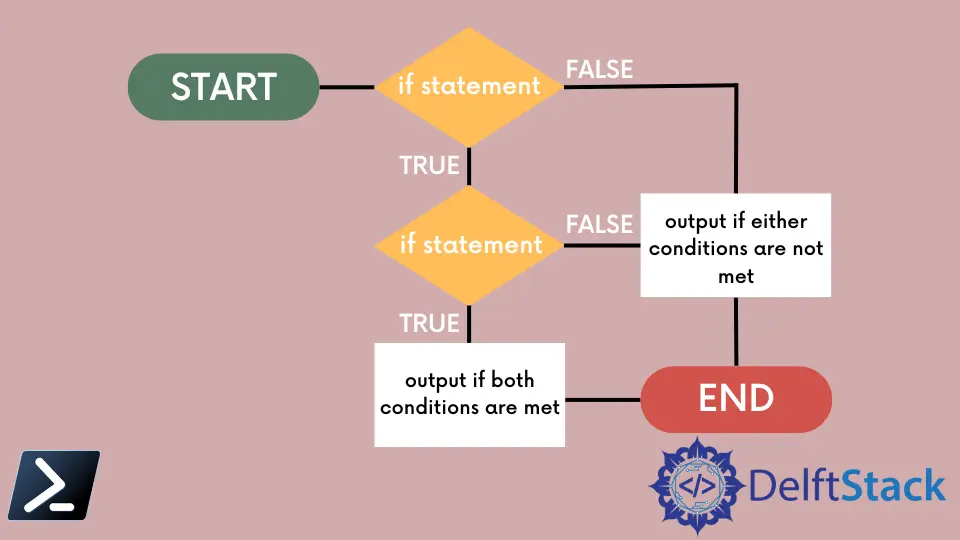如何在 if 語句中結合多個條件
-
PowerShell 中的
if語句 -
在 PowerShell 的
if語句中使用邏輯運算符結合多個條件 -
使用多個運算符在 PowerShell 的
if語句中結合多個條件 -
在 PowerShell 中嵌套
if語句以結合多個條件 - 結論

在 PowerShell 中,if 語句是進行決策的重要工具。然而,許多任務需要您結合多個條件以獲得更精確的控制。
本文將探討如何在 PowerShell 的 if 語句中使用邏輯運算符結合多個條件的各種方法。
PowerShell 中的 if 語句
以下是 if 語句的簡單範例。如果括號內的條件評估為真,則將執行命令 Write-Host "2 is equal to 2."。
代碼:
if (2 -eq 2) {
Write-Host "2 is equal to 2."
}
如果括號 () 中指定的條件評估為 $true,那麼它將執行大括號 {} 中的命令。
輸出:
2 is equal to 2.
如果條件為 $false,則會跳過該代碼區塊。上面的範例使用了一個條件,但您也可以在 if 語句中評估多個條件。
在 PowerShell 的 if 語句中使用邏輯運算符結合多個條件
邏輯運算符用於在 PowerShell 中連接語句和表達式。您可以使用單一表達式來測試多個條件。
PowerShell 中支持的邏輯運算符為 -and、-or、-not、-xor 和 !。本文將僅討論如何使用 -and、-or、-not 和 -xor 運算符在 PowerShell 的 if 語句中結合多個條件。
在 PowerShell 的 if 語句中使用 -and 運算符結合多個條件
以下範例使用 -and 運算符在 if 語句中連接兩個語句。如果第一個條件 5 小於 10 為真且第二個條件 7 大於 5 為真,將執行 Write-Host 命令。
代碼:
if ((5 -lt 10) -and (7 -gt 5)) {
Write-Host "The above conditions are true."
}
輸出:
The above conditions are true.
由於在這種情況下兩個條件都為真,因此代碼區塊被執行,並在輸出中打印消息 "The above conditions are true."。
在 PowerShell 的 if 語句中使用 -or 運算符結合多個條件
在這段代碼中,我們使用 -lt(小於)和 -gt(大於)運算符來檢查 5 是否小於 10 或 7 是否大於 5。然後,我們使用 -or 運算符來檢查 (5 -lt 10) 或 (7 -gt 5) 是否為真。
代碼:
if ((5 -lt 10) -or (7 -gt 5)) {
Write-Host "At least one of the above conditions is true."
}
else {
Write-Host "Neither of the above conditions is true."
}
輸出:
At least one of the above conditions is true.
由於在原始代碼中兩個條件都為真,因此打印出 "At least one of the conditions is true."。
在 PowerShell 的 if 語句中使用 -not 運算符結合多個條件
在以下代碼中,我們有一個變數 $number 代表一個數值。我們使用 -lt(小於)和 -gt(大於)運算符來檢查該數字是否小於 5 或大於 10。
-or 運算符用於結合左右兩側的兩個條件。如果至少有一個條件為真,它將返回真。由於兩個條件都為假,因此 -or 表達式評估為假。
-not 運算符應用於 -or 表達式的結果。由於 -or 表達式為假,應用 -not 使其變為真。
代碼:
$number = 7
if (-not ($number -lt 5 -or $number -gt 10)) {
Write-Host "The number is between 5 and 10 (inclusive)."
}
else {
Write-Host "The number is outside the range of 5 to 10."
}
輸出:
The number is between 5 and 10 (inclusive).
由於 -not 運算符使結合的條件為真,因此 if 區塊中的代碼被執行。輸出顯示 $number = 7 的值落在 5 到 10(含)的指定範圍內。
在 PowerShell 的 if 語句中使用 -xor 運算符結合多個條件
以下代碼檢查兩個條件並使用 -xor 運算符來確定其結合的真值。在 if 語句中,有兩個條件:第一個條件是 5 是否小於 10,第二個條件是 7 是否大於 5。
-xor 運算符是一種排他性 OR 運算符,這意味著它在恰好一個操作數為真時返回真,如果兩個操作數都為真或都為假,則返回假。
在這種情況下,兩個條件都為真,因此 -xor 表達式評估為假,並執行 else 區塊中的代碼。
代碼:
if ((5 -lt 10) -xor (7 -gt 5)) {
Write-Host "Exactly one of the above conditions is true."
}
else {
Write-Host "Neither or both of the above conditions are true."
}
輸出:
Neither or both of the above conditions are true.
輸出打印 "Neither or both of the above conditions are true.",因為這表明這兩個條件都不是單獨為真;兩個條件要麼一起為真,要麼一起為假。
使用多個運算符在 PowerShell 的 if 語句中結合多個條件
同樣,您可以在 PowerShell 的 if 語句中使用邏輯運算符結合多個條件。在此範例中,根據結合條件是否為 true 或 false 執行不同的命令。
下面的代碼使用邏輯運算符 -and 和 -or 結合多個條件。如果任何這些條件為真,則將執行第一條命令(Write-Host "It is true."),否則將執行第二條命令(Write-Host "It is false.")。
代碼:
if (((10 -lt 20) -and (10 -eq 10)) -or ((15 -gt 5) -and (12 -lt 6))) {
Write-Host "It is true."
}
else {
Write-Host "It is false."
}
輸出:
It is true.
在這裡,if 語句檢查結合條件並根據條件的評估執行適當的命令區塊。由於條件為真,因此打印了消息 "It is true."。
請記得將每組條件放在括號 () 中,並使用適合您特定要求的邏輯運算符。
在 PowerShell 中嵌套 if 語句以結合多個條件
當您有需要多層評估的複雜條件時,嵌套 if 語句可能會非常有用。例如,當您需要在特定上下文中檢查條件或根據不同條件執行不同操作時,嵌套 if 語句可以實現更結構化的方式。
在這段代碼中,我們宣告一個變數 $number = 15。然後,我們創建外部 if 語句來檢查是否 $number 大於或等於 10。
如果外部條件為真,嵌套的 if 語句檢查 $number 是否小於或等於 20。
代碼:
$number = 15
if ($number -ge 10) {
if ($number -le 20) {
Write-Host "The number is between 10 and 20."
}
}
輸出:
The number is between 10 and 20.
在這段代碼中,外部 if 語句檢查 $number 是否 大於或等於 10。如果滿足此條件,則繼續進入嵌套的 if 語句,該語句檢查 $number 是否 小於或等於 20。
只有當兩個條件都為真時,才執行 Write-Host 命令。在輸出中,兩個條件都得到了滿足,並打印消息 "The number is between 10 and 20."。
結論
總之,在 PowerShell 的 if 語句中結合多個條件對於製作高效的腳本至關重要。通過邏輯運算符 -and、-or、-not 和 -xor,您可以創建複雜的條件邏輯以解決廣泛的腳本挑戰。
無論是簡單的條件還是嵌套的 if 語句,PowerShell 提供了強大的工具來幫助您做出明智的決策,並在腳本中執行正確的操作。
